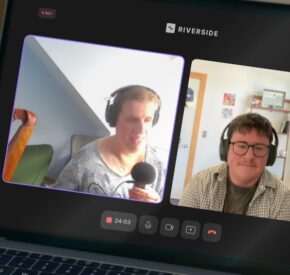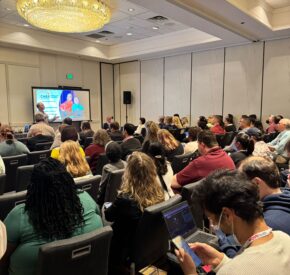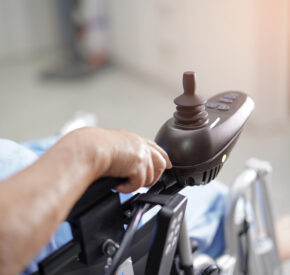Strokes and Accessibility
Article 19 speaks to a stroke survivor who increased commitment to accessibility

In this episode of Article 19, host Kristen Witucki interviews Robert Jolly, a stroke survivor and accessibility advocate. Robert discusses his journey into accessibility, how his stroke experience deepened his understanding of its importance, and his current work in promoting inclusive technology within the government. He emphasizes the importance of community support and recommends valuable resources like the W3C Web Accessibility Initiative and Accessibility.digital.gov for those seeking to learn more about accessibility.
Meet our guests:
- Robert Jolly is an accessibility-focused product manager in the Technology Transformation Services (TTS) at General Services Administration. Robert has previously been co-lead for the TTS Accessibility Guild, and was a member of the W3C’s Web Accessibility Initiative (WAI) Education and Outreach Working Group.
Listen to more Article 19 Podcast Episodes
Full Transcript
Access the PDF Transcript
Intro:
Expression is one of the most powerful tools we have. A voice, a pen, a keyboard. “The real change which must give to people throughout the world their human rights, must come about in the hearts of people. We must want our fellow human beings to have rights and freedoms which give them dignity.” Article 19 is the voice in the room.
Kristen:
Hello, everyone and welcome to Article 19. My name is Kristen Witucki. I’m a content creator and accessibility specialist at Tamman. And I’m also the host of our conversation today. One condition that can cause a great deal of rapid change, adjustment and long recovery is stroke, which can and does occur at any age. Here are a few statistics from the CDC. In 2021, one in six deaths from cardiovascular disease was due to stroke. Every 40 seconds, someone in the United States has a stroke. Every three minutes and 14 seconds, someone dies of stroke. Every year, more than 795,000 people in the United States have a stroke. About 610,000 of these are first or new strokes. About 185,000 strokes, nearly one in four are in people who have had a previous stroke. About 87% of all strokes are ischemic strokes in which blood flow to the brain is blocked.
Our episode today will connect you with a stroke survivor who was aware of disability for a long time and came to the cause of accessibility with even more conviction once he had had a stroke. Article 19 is a call for others to join us in a bigger conversation around the ADA, digital accessibility, and access to information. At Tamman, we are working to build the inclusive web every day. But to do that, we need all of us working together and learning together. Thanks for listening to Article 19 and let’s get this conversation started. I will now formally bring in our guest, Robert Jolly, product manager at 10x inside the Technology Transformation Services, part of the general services administration. As a disclaimer, anything Robert says represents his own life and does not reflect the views or goals of the administration. With that disclaimer out of the way, Robert, welcome to Article 19. Thanks for coming.
Robert:
Thank you, Kristen.
Kristen:
Robert, how did you initially become interested in accessibility and what kind of accessibility work did you do in the beginning?
Robert:
I was doing work with a boutique web design agency around 2006, 2010 timeframe. And our specialty was designing high end, good-looking websites but with the basis of Web Standards. And so, Web Standards, we really believed that that was kind of the foundation for accessibility. And so we would talk to that and sell that as such. Accessibility isn’t necessarily guaranteed because you’re doing something with Web Standards and that’s something that I’ve learned since diving deeper into accessibility. But at the time, that’s where I got my first introduction to the importance of web accessibility. We wanted our work to reach the most people. I wanted the internet to be a level playing field for folks, so that folks could equally access information and services and functionality.
And so, through that time period, I also was exposed to some folks speaking at conferences. One of those was Derek Featherstone who a colleague of mine, at the time, at the agency said, “You should go see Derek talk. You also may wanna talk with him, learn more about this. He’s really compelling with this.” And so, I ended up diving deeper into accessibility and being aware of it and being aware that there are folks that know so much more out there about this and that I could learn from at the time. And so, that was how my interest in accessibility started. I then started working in accessibility after I left the design agency. I ended up working as a product manager and project manager on accessibility related projects of Derek Featherstone’s company at the time, Simply Accessible. I then became very immersed in the work itself and started learning from my colleagues and learning at conferences and trainings around accessibility and then working directly with people with disabilities as well as the basis of the accessibility work that I was doing.
Kristen:
Yeah, it’s so important to include the users you’re helping because that will enable you to really understand where they’re coming from and how their experiences are, whether the technology is really working for them. And those of us who work in accessibility know that once you start learning about it, it’s like the rock rolling down the hill, gathering speed. Did that increased learning about accessibility and your excitement about it also contribute to your stress? What circumstances might’ve led to your stroke or what do you remember about that time?
Robert:
So, At that time, when I had the stroke, I was in a transition period before I had started the work directly with accessibility project management and product management. I had left the web design agency and I thought to myself, “Oh, I’m kind of burnt out. I’ve worked really hard the last five years and I feel like I need to take a break. And maybe even do something entirely different.” So, I was in school for nursing at the time. I was thinking, “Oh, a career change might be good for me.” I was an EMT 15, 20 years before. And so, I liked the medical field, so I was taking classes. But there was also a lot of stress in my life. And I won’t go into all of the different stressors that I had at the time, but there were many. And school was stressful, but something I wanted to do. But I think it’s kind of the cumulative stress of working at the agency and really being overworked in a way. And some of that was my fault. Some of that was just the situation itself. And then other stressors in my life, I think ended up causing me to kind of have the stroke.
Now, it was a build up over a long time, I think. I had an ischemic stroke. It was the result of a vertebral artery dissection, which can be caused by things like a motor vehicle accident, like when you get whiplash. Or, if you are scuba diving, or if you’re even getting a chiropractic neck adjustment. Those can cause vertebral artery dissections. But this wasn’t caused by any of those things. What we’ve thought, my doctors and I, is that there was a history of high blood pressure that I had. And I was very physically active. I was doing a lot of running, a lot of biking. I loved to ride bikes. So, I was monitoring my blood pressure with my physician, but it wasn’t ideal. And so, over the course of time, that stress that that high blood pressure put on my vertebral artery in the back of my neck caused a tear or a dissection in the artery and it ended up causing this ischemic stroke to happen. So, that was kind of the circumstance surrounding my stroke. One evening, I was working a little bit late on a paper for the
school project. I was a little stressed out about that. I went to bed kind of late. But then woke up – I don’t know. I must not have slept very long. Maybe an hour or two. But I woke up, it was kind of the middle of the night, and I had the worst headache that I had ever experienced. And I would get headaches from time to time. I’d get headaches if I didn’t drink enough water during the day or if I was sick in some way. But this was different. This was a headache that just enveloped my entire – it seemed like it enveloped my entire brain. And it was more intense, more severe, pounding. It was just unimaginably bad. And I was thinking to myself, “What’s going on? Is this a migraine?” Because I’ve never had migraines. I was just thinking, “OK. This is the worst headache of my life. And I’ve never had migraines. People have described them to me before, and maybe this is a migraine. Maybe I’m getting a migraine. What’s this?”
So, I got up out of the bed and I was walking to go to the bathroom. And I wanted to get a glass of water and take some ibuprofen or something, some medicine. And, as I was walking to the bathroom, I needed to sort of lean up against the wall as I was walking. So, I was unable to walk straight. But I didn’t really realize that was a sign that I was having a stroke. At the time, I was like, “Oh, this is just a bad headache and I’m sleepy and I’m having to prop myself up.” So, I took some ibuprofen and went back into the bed. And by this time, my wife had woken up and she was concerned, and she was like, “Maybe I need to take you to the ER.” And I’m like, “I don’t know. I don’t know. You know, it’s just a really bad headache. Maybe I’m having a migraine or something.” And so, when a few hours rolled around, and I really hadn’t slept. I couldn’t really sleep. I told her it was just insanely bad still. The headache was just terrible. I told her also that I couldn’t really walk straight. And so, she took me to the ER, and they checked me out. They did a CT scan. They did two spinal taps to get some spinal fluid to see if there was a brain bleed. And they sent me home with a diagnosis of a headache.
They gave me some really good pain medications, so I was feeling no pain at the time that I left the ER. But they said, “Oh, you should follow up with your doctor afterwards and find out is there anything else going on.” And so, my doctor met with me, I think, the day after I went to the ER, which was great. I got an appointment, met with him and he said, “Oh, I’m going to send you for an MRI.” And he sent me for the MRI, and I got that test done. I think a week later. And all the time, he had given me some more pain medication, but he said, “The headaches may remain because of the spinal tap where they took some spinal fluid from you. But just let me know how things are going.” Well, when the MRI results came back, it had been maybe 10, almost 14 days. They said, “Oh, he has ischemic insult”, which is doctor terms for having a stroke basically. And so, they immediately sent me to a neurologist, and we had – I became a frequent flyer of the MRI machines in the Philadelphia, Delaware area.
Kristen:
That is intense. Was the recovery more difficult because of the delay in the treatment you got?
Robert:
I think the recovery was as good as it could be. It was still difficult, and I’ll talk a little bit more about that. But it was as good as it could be given the circumstances. I think it could’ve been a lot worse had I not gone for the follow up visit with my doctor because they had missed it at the ER. They were looking for a brain bleed and they didn’t find that. And they didn’t see a large amount of evidence for an ischemic stroke. But it could’ve been a lot worse had I not gone to the doctor. But I think my sort of like symptoms in recovery, since I didn’t have a recurrent stroke or right after the fact, some people can have multiple strokes in a row or in succession. That didn’t happen to me, but what did happen with my recovery was that I was extremely, extremely sensitive to bright lights. I couldn’t look at a computer for more than five or 10 minutes at a time. I couldn’t watch the TV when I was recovering on the couch for any more than 5 or 10 minutes at a time. I had to draw the shades and make sure that things didn’t get too bright in there because I was really light sensitive.
I had ongoing headaches for at least three weeks after the stroke and I want to even think that it was a little bit longer than that. There was a period of time where it just hurt to exist. And that was tough. It was tough to think about, “What do I need to do for the schoolwork that I was trying to do? Does this mean this going to be permanent?” I didn’t know at the time. And it affected my concentration as well and sometimes I even think sometimes my brain needs a moment to kind of connect thoughts and then translate those into words. When I’m talking right now, sometimes I’ll have a pause and I need to figure out, “What am I trying to say here?” My brain knows what it’s trying to say, but am I able to say it correctly?
Kristen:
So, How long did recovery take in general? How long did it take you to feel closer to what your
previous experience might have been?
Robert:
So, It took, I would say, in the neighborhood of three to six months for me to feel like I could operate normally or close to normal, like what I had before the stroke. My normal. So, It took a while. It was fortunate that I didn’t have serious deficits moving forward like long-term. I do think there are some things that are different about the way that my brain works now than previously. But it was a significant enough amount of time to really make an impression on me that this is very real. Right? It can happen to anyone, even if you are in relative good health. That took a while. And I was on blood thinner medication for – I think it was about six months. Maybe nine months. Where I would have to go and get blood tests twice a week just to check my levels to make sure that things were OK.
Kristen:
How did your knowledge of accessibility help the recovery process?
Robert:
Oh That’s a great question. I do think it helped. I was more familiar because of my exposure to accessibility in the industry that I was in that I was able to change settings on my computer. So I used kind of a lower contrast setting on my computer to help with allowing me to be able to communicate, say, with my teachers and let them know like, “Hey, this is when I think I’m gonna come back to class. This is when I can get you that paper that I was writing the night before I stroked out.” I was able to dim things down, so that I could actually perform some functions on the computer. I also knew that I could take more time and I could express, “Hey, this is what happened to me”, to folks. So, that was another thing that accessibility brought to me, is it’s not something to hide. You don’t have to disclose everything. Right? But it’s not something that you need to fear that there are going to be repercussions of. And one case in point is that you know, I had a blog at the time, and it was nothing that anybody ever really read. But when I had my stroke, I blogged about it, and I wrote all about what happened. And then, I had a few folks that were very well meaning – and, well, one person in particular reached out and said, “Oh, aren’t you concerned about what this might do to your job prospects if you are telling me about your stroke?”
And I thought about it a little bit. And I was like, “Well, A, if anyone is going to judge me or think that I can’t contribute, I can’t do the work that needs to be done, then I probably don’t want to work for them anyway or work with them.” But, that’s one of the things that I think accessibility taught me is that I could look for answers. I could look for adaptations or help. And I could reach out as well, if I needed to. So, that was, I think, huge for me, just having that bit of background information, that exposure to the fact that people with disabilities, whether they’re temporary, permanent, situational, can and should be able to access technology and use it in ways that anyone else can.
Kristen:
That’s just so true and brave and vulnerable. I can’t imagine just the mental and physical energy of blogging about a stroke in the moment. Not only dealing with your recovery, but also recording it so you can remember it for yourself and help others. That’s really cool.
Robert:
It took me a while to put that blog post together. And then I did an update after that. But yeah, I’ve since let the site die and go by the wayside. But somewhere on the internet it’s probably preserved.
Kristen:
Yeah, in the ether. [laughter] So Robert, what advice can you give to stroke survivors and their loved ones as the survivors recover and relearn?
Robert:
So, everyone’s situation is slightly different. And, so I do think that folks don’t need to despair too much. I mean obviously, yes, a stroke is very serious and it’s not something you take lightly. It’s also something that can have very permanent lasting effects and much more serious than what I had. But I do think there are ways to adapt and to continue to grow after having a stroke. And so, that’s the big takeaway that I have is that these things happen. I ended up having a support site called “VADrecovery.com” that I also let dwindle. But we had a number of people that had a very similar experience to me, and folks were sharing their stories and sharing their worries and asking questions.
And it was really helpful for me at the time to know like, “Hey, first, I’m not alone. And B, neither are you, if you’re in this situation.” And so, having that sort of community, I think is really important. And so, the advice that I would give is to reach out, to seek others that have either gone through this or that can offer some sort of assistance as well. Because they’re out there. As significant a medical event as this is, it’s not uncommon. So…
Kristen:
What kind of accessibility work do you do now?
Robert:
So, now, I get to evangelize accessibility for teams here at Technology Transformation Services. I’m directly involved in different efforts where we are evaluating the accessibility of products or services that are provided to the government for the American people. So, I’ve led the Technology Transformation Services Accessibility Guild previously. I’ve provided training for colleagues around accessibility and generally, get to offer advice and help. And then, in our 10x program that I work for, I’m a product manager and project coordinator. And so, we have a number of projects that touch on accessibility and even one that’s being worked on right now is a project about baked in accessibility for government documents. And so, there’s a team that’s exploring that and I’m able to, based on the contacts that I have in the accessibility world and industry, can help connect them with the right people to talk to to keep exploring like what are the possible ways that we can solve that problem. So, it’s super exciting that I get to continue to do accessibility work, but with a potential impact that’s much larger than a small team.
Kristen:
That’s so amazing and interesting that you can connect all those people in all the different roles and make it real for everyone and bringing users into that experience. And I just love the creative sensibility of being an accessibility evangelist.
Robert:
I am shy about having people say that I’m an accessibility expert. I think I have immersed myself for a number of years in accessibility. And so, I get where that comes from, but I also feel like I’ve learned so much about accessibility every day, especially if I want to. Right? You know, sometimes it’s easy to sort of say, “Oh, OK, I can kick back a little bit.” But it’s not like that. It can go so wide and so deep that I just like to evangelize the importance of accessibility, the spirit of helping make software and technology and even hardware work better for people, all people. And so, I love it when I get to see folks learn and embrace accessibility and then apply it where they become real experts [laughter] in their field with that. And maybe I’ve helped play some part by evangelizing it. But yeah, it’s fun.
Kristen:
What are some digital resources that people use in your line of work that you can recommend to anyone who wants to learn more about accessibility?
Robert:
So, I think almost everything that the W3C puts out is super informative and helpful. Sometimes it can be overwhelming, so that – W3C’s web accessibility initiative, especially the Education and Outreach Working Group. And I was a part of that for about three years. I was a part of that working group through the non-profit I worked for, Knobility. But I really love the resources that that Education and Outreach Working Group put out. So, you can start at a very high level with some of their introductory and perspectives information. But then dig deep in a number of areas on implementation, the interpretation of – or understanding of the success criterion, not necessarily interpretation of. But the understanding of why they, the success criteria, exist and how you can test for those and what they’re meant to do. I think it’s really spot on. And there’s just so much information that I think sometimes people feel overwhelmed or a little bit scared about diving into such a big wealth of information.
And there’s a site that I inherited, in a way, as a product manager when I joined the government. There was a site that was stood up before I joined the government by someone within the organization here that they stood up accessibility for teams. That’s a really good resource that the government has, and it’s housed on digital.gov right now. But I think you can get to it at accessibility.digital.gov. That one is a really good introductory kind of role-based accessibility resource. So, If you’re a content specialist or if you are a product person or if you’re an engineer developer of one sort or another or a designer or a UX researcher, you can find information that’s geared toward you at that site. So, I really love that as a resource you can bring your whole team into, if you’re trying to build or buy accessible products.
Kristen:
How has your life journey changed as a result of your own later connection with disability?
Robert:
So I think my journey changed more based on just like really wanting to focus on making sure that the work that I was doing and that I was involved with in some way with the organizations that I worked with were really squared with helping people. And especially people with disabilities. But I think when we focus on ensuring equal access and that basic human right of being able to function in a society that’s growing evermore digitally connected that it helps everyone. I really think that my own disability journey and event really solidified that focus for me. And really, I don’t see ever necessarily losing that focus. I may move into different areas of work, but I think that component of the work, that accessibility pillar of the work, will always be there and standing to support what I’m doing.
Kristen:
Well, thank you, Robert, for your wonderful testimony for accessibility and sharing your story and your knowledge with all of us on Article 19. We really, really appreciate it. My final question is just kind of a fun one. Can you recommend a TV show, a movie, a game, a book or an album or a podcast that we should check out?
Robert:
I’m gonna give you a band. So, Khruangbin is a really interesting three-person band out of Houston, Texas, that I was just exposed to, but they’ve been around for a number of years. But they’re pretty amazing and yeah, they just sound super unique. But it’s a really straightforward, easy to access set of music that they put out. And the spelling of it is K-H-R-U-A-N-G-B-I-N and it’s Thai for airplane, I believe. You should check them out if you haven’t heard them play or haven’t heard any of their stuff, it’s pretty awesome, I think. And it’s so simple with a really simple drum set, one guitarist and one bassist. And they’re amazing.
Kristen:
Robert, thank you so much for your brave and vulnerable story. Before we close out the show, I just want to end with some recommendations from the CDC. The stroke treatments that work best are available only if the stroke is recognized and diagnosed within three hours of the first symptoms. Stroke patients may not be eligible for these if they don’t arrive at the hospital in time. If you think someone may be having a stroke, act F-A-S-T and do the following tests. F is for face. Ask the person to smile. Does one side of the face droop? A is for arms. Ask the person to raise both arms. Does one arm drift downward? S is for speech. Ask the person to repeat a simple phrase. Is the speech slurred or strange? And T is for time. If you see any of these signs call 911 right away. Note the time when any symptoms first appeared. This information helps healthcare providers determine the best treatment for each person. Do not drive to the hospital or let someone else drive you. Call 911 for an ambulance so that medical personnel can begin life-saving treatment on the way to the emergency room.
Our guest today was Robert Jolly. I am our host Kristen Witucki, and our producers are Markus Goldman. If you like what you heard today and want to explore more about digital accessibility technology, our company culture, or anything else, schedule a time to meet with us. You can find the whole Tamman team at tammaninc.com. That’s T-A-M-M-A-N-I-N-C.com Don’t forget to sign up for our newsletter while you’re there, so you never miss an event or an insight from us. And be sure to rate our podcast five stars on Spotify, Apple Podcasts or wherever you hear us. It really helps our podcast grow and reach new audiences. Make sure to follow us, hit that bell icon so you never miss an episode. If social media’s more your style, you can also follow us at Tamman Inc on LinkedIn, X, Instagram or Facebook and share our podcast on your favorite platform. Until next time, thank you so much for listening and being a part of Article 19. Take care.
Show Notes
Technology Transformation Services
Accessibility Guild in the Technology Transformation Services (TTS)
10x: the federal government’s very own venture studio
Education and Outreach Working Group: W3C’s web accessibility initiative’s
Accessibility for Teams
CDC Stroke Treatments
F-A-S-T Stroke Test




